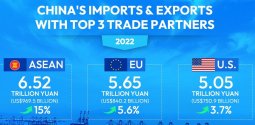Vietnam is doing great - but it's the GDP of Heilongjiang with the population of Henan.
Singapore is great, it's got the population of Chaoyang district in Beijing.
India's also big and growing, but it's base is so small that it doesn't move the needle globally. Majority of Indians consume similarly to Sub-Sahara Africa (see my comment on Africa below).
Brazil central bank overnight rate is 13% - inflation is running hotter than that.
A friend visited Indonesia to look at 'great investment opportunities' and came back saying that consumers are struggling.
Peru just had a coup, Chile is okay, but it's population smaller than Beijing.
Africa - sure, lots of people but they barely can feed themselves.
What you need to understand is that the Global South doesn't matter *today*, economically speaking. Global GDP is ~100 trln USD, top 20 economic entities account for about 80 trln of that 100 trln. Wake me up in a decade when Belt and Road starts to work out and their economies start growing.
View attachment 105052
Folks, if you're living in North America feeling the grocery bills - it's not like basic commodities aren't globally fungible goods that don't have the same prices - people in the global south are struggling 5-10x worse than you are.

